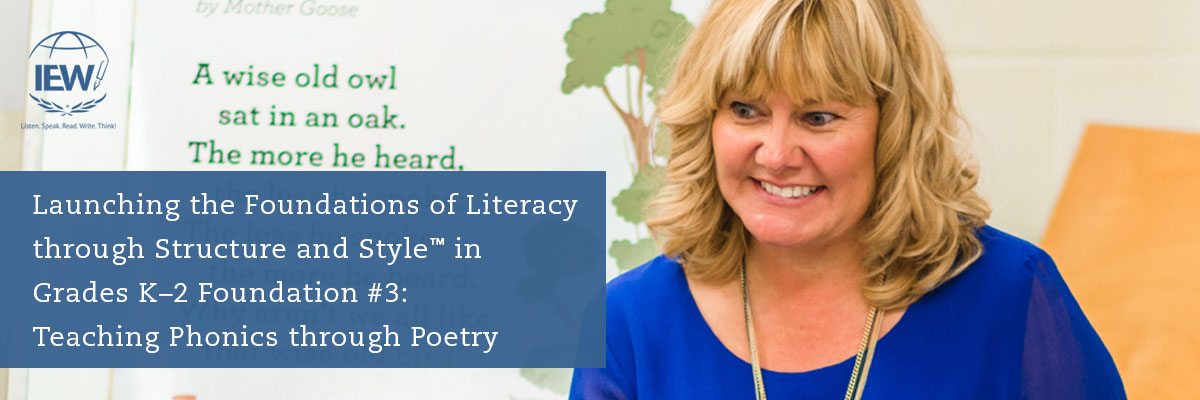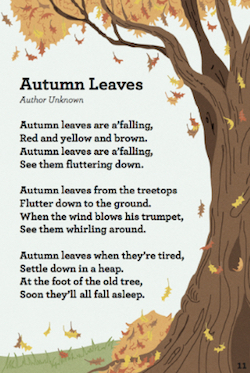
In this blog series, we’ve focused on how the lesson plans in IEW's primary classroom materials use poetry study and memorization as the launching point for building oral language and vocabulary. Poetry is also an easy and effective way to teach grammar skills and is the ideal medium for learning phonics. Why does IEW include phonics instruction in our writing lessons? We’re accustomed to thinking of phonics in learning to read, but how does phonics connect to writing? Research has revealed something unexpected: “Phonics instruction can become more engaging and effective if we teach students to write words before they read them” (Herron).
Like grammar, phonics has a reputation of being dry, boring, and old-fashioned. In the 1980s many teachers abandoned teaching phonics in favor of the whole language approach. Those who embraced the whole language philosophy typically valued creative expression over skills in the teaching of writing. Regardless of these beliefs, much of the scientific research has confirmed that phonics is critical for literacy. However, the type of phonics instruction matters if we want to nourish children’s language development. In 1998, Louisa Moats, a teacher and researcher for almost fifty years, identified the problem this way:
One of the most fundamental flaws found in almost all phonics programs, including traditional ones, is that they teach the code backwards. That is, they go from letter to sound instead of from sound to letter…. The print-to-sound (conventional phonics) approach leaves gaps, invites confusion, and creates inefficiencies. (Herron)
Phonics instruction should focus on students constructing words before trying to read them (Herron). In other words, instead of teaching children to decode first, we should teach them encoding with activities that build phonemic awareness using rhymes, songs, and games that manipulate the sounds in words and then help them see the connection. IEW fans are very familiar with someone who was way ahead of her time in teaching phonics this way.
Anna Ingham (The Blended Sound-Sight Program of Learning) practiced a truly balanced approach to literacy: add new ideas and methods if they work but don’t abandon things that have worked and proven successful in the past (12). Like Dr. James Webster, her nephew, she knew deep in her heart that using strategies that work and engage students are more effective than the latest new ideas in education. Mrs. Ingham used poetry to help children make the connection between encoding during the writing lessons and decoding during the phonics lessons.
Putting It All Together in IEW’s K–2 Lessons
The weekly lesson plans in IEW’s Classroom Supplements were inspired by Mrs. Ingham’s belief in the power of poetry in language development. As students memorize a new poem each week, they are playing with and memorizing rich language, rhythms, and rhymes while building their vocabularies. This makes it easy to incorporate phonics through encoding activities into poetry study. Using the poem as a launching pad for instruction, the phonics lessons take only a few minutes a day. Here’s a sample from grade 1.
Week 8: Day 1
Read and discuss “Autumn Leaves”
Explore unfamiliar words, such as fluttering and whirling. Demonstrate with real or paper leaves.
Listen for rhymes: brown/down, ground/around, heap/asleep.
Review ow and ou. Recite the ow Clown Jingle. (Appendix 5, p. 325 in Classroom Supplement).
Review ow says long o at the end of words.
* Visit Sound City, and do “knock-knocks.”
Teacher: “Knock-knock”
Students: “Who’s there?”
Teacher and Students (in unison): “O-w” (Say the letter names)
“O-w says “oh” at the end of words as in yellow, grow, snow, and rainbow.”
* Note: Sound City is an optional activity included in our K–2 lesson plans. If your school already has a phonics program in place, omit the Knock-Knock activity.
We know that our method works. We hear evidence of this every day from teachers who share their experiences and stories from their classrooms. One of those teachers is Jackie Hammond. Jackie, a kindergarten teacher in Elementary School District #53 in Bourbonnais, Illinois, was surprised by the reading/writing connection in Structure and Style. “Not only do my students have the confidence to put their ideas into a well-written format, their reading and comprehension skills improved. ‘Soared’ would be a better word.” First grade teacher Jacinta O’Martin of Berwyn North School District in Illinois had this to say:
Teaching writing to six-year-olds has always felt like an uphill battle! However, since integrating IEW into our first grade English Language Arts instruction, we have seen tremendous growth in our students’ abilities. The IEW program uses a systematic, thoughtful, and structured approach that engages the whole learner. IEW gives teachers a clear and defined starting point, gives students a focus, and makes writing accessible to all learners.
We hope that, like the IEW team, you appreciate the powerful role encoding plays in growing your young writers and readers. Taking our cue from Anna Ingham’s approach that was purposeful while remaining nurturing, we are confident that our primary lessons are based on a truly balanced approach to literacy. They focus on strategies that are both engaging and proven to work.
To learn more about our instructional materials for full-time classroom teachers, please visit our website IEW.com/Schools or call 800.856.5815 and ask to speak to one of our Educational Consultants.
See these previous blog posts in the “Launching the Foundations of Literacy through Structure and Style in Grades K–2 series.”
Foundation 1: Language Development through Poetry
Foundation 2: Building Grammar Skills with Poetry
Foundation 4: Facilitating Composition through Handwriting Instruction and Copywork
Works Cited
Hanford, Emily. “Kids Struggle to Read When Schools Leave Phonics Out.” The Hechinger
Report, 11 Sept. 2018, https://hechingerreport.org/kids-struggle-to-read-when-schools-leave-phonics-out/. Accessed 22 Sept. 2018.
Herron, Jeannine. “Why Phonics Teaching Must Change.” Educational Leadership, ASCD, Sept. 2008,
www.ascd.org/publications/educational-leadership/sept08/vol66/num01/Why-Phonics-Teaching-Must-Change.aspx. Accessed 22 Sept. 2018.
Ingham, A.G. The Blended Sound-Sight Program of Learning, sixth ed., Nisku Printers, 2004.
|
Jean brings 34 years of classroom experience to IEW, having taught grades 1–6 in New York, Virginia, and in California, where she taught sixth-grade language arts in the Rocklin Unified School District. She was introduced to IEW in 2001 when a colleague shared Student Writing Intensive videos at weekly school staff meetings. As a result of student progress and teacher enthusiasm at her school, RUSD brought Andrew Pudewa to Rocklin many times over the next several years to train district teachers, resulting in improved student writing and test scores district-wide. Named Rocklin’s “Elementary Teacher of the Year” in 2001, Jean was also included in the 2004 and 2005 editions of Who’s Who Among America’s Teachers. |

